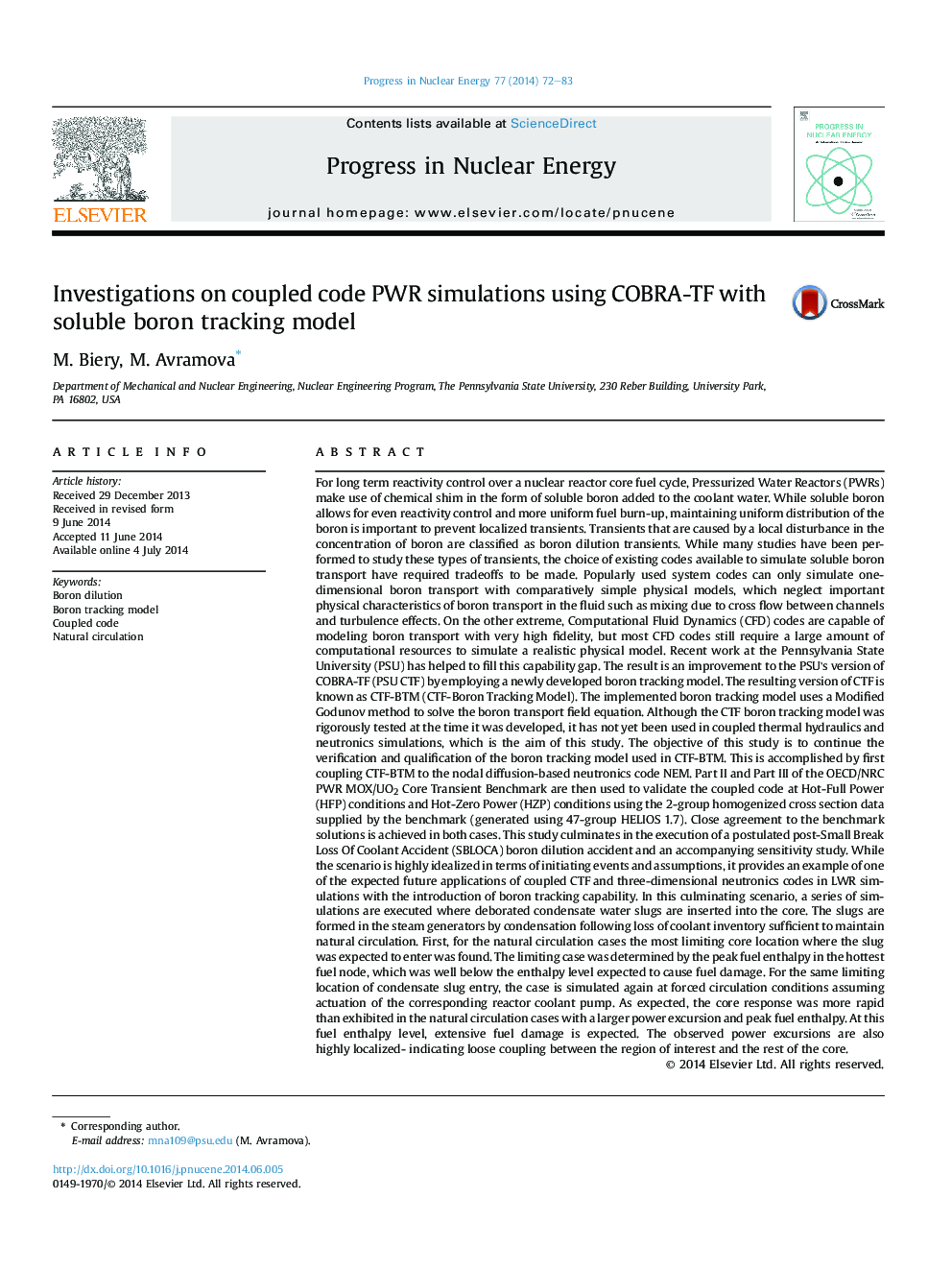| کد مقاله | کد نشریه | سال انتشار | مقاله انگلیسی | نسخه تمام متن |
|---|---|---|---|---|
| 1740580 | 1521761 | 2014 | 12 صفحه PDF | دانلود رایگان |

• Testing COBRA-TF boron tracking model in coupled code PWR simulations.
• Simulation and analysis of postulated post-SBLOCA boron dilution accident.
• Sensitivity study on the most limiting core location of deborated slug entrance.
• Comparative analysis of simulations of natural and forced circulation cases.
For long term reactivity control over a nuclear reactor core fuel cycle, Pressurized Water Reactors (PWRs) make use of chemical shim in the form of soluble boron added to the coolant water. While soluble boron allows for even reactivity control and more uniform fuel burn-up, maintaining uniform distribution of the boron is important to prevent localized transients. Transients that are caused by a local disturbance in the concentration of boron are classified as boron dilution transients. While many studies have been performed to study these types of transients, the choice of existing codes available to simulate soluble boron transport have required tradeoffs to be made. Popularly used system codes can only simulate one-dimensional boron transport with comparatively simple physical models, which neglect important physical characteristics of boron transport in the fluid such as mixing due to cross flow between channels and turbulence effects. On the other extreme, Computational Fluid Dynamics (CFD) codes are capable of modeling boron transport with very high fidelity, but most CFD codes still require a large amount of computational resources to simulate a realistic physical model. Recent work at the Pennsylvania State University (PSU) has helped to fill this capability gap. The result is an improvement to the PSU's version of COBRA-TF (PSU CTF) by employing a newly developed boron tracking model. The resulting version of CTF is known as CTF-BTM (CTF-Boron Tracking Model). The implemented boron tracking model uses a Modified Godunov method to solve the boron transport field equation. Although the CTF boron tracking model was rigorously tested at the time it was developed, it has not yet been used in coupled thermal hydraulics and neutronics simulations, which is the aim of this study. The objective of this study is to continue the verification and qualification of the boron tracking model used in CTF-BTM. This is accomplished by first coupling CTF-BTM to the nodal diffusion-based neutronics code NEM. Part II and Part III of the OECD/NRC PWR MOX/UO2 Core Transient Benchmark are then used to validate the coupled code at Hot-Full Power (HFP) conditions and Hot-Zero Power (HZP) conditions using the 2-group homogenized cross section data supplied by the benchmark (generated using 47-group HELIOS 1.7). Close agreement to the benchmark solutions is achieved in both cases. This study culminates in the execution of a postulated post-Small Break Loss Of Coolant Accident (SBLOCA) boron dilution accident and an accompanying sensitivity study. While the scenario is highly idealized in terms of initiating events and assumptions, it provides an example of one of the expected future applications of coupled CTF and three-dimensional neutronics codes in LWR simulations with the introduction of boron tracking capability. In this culminating scenario, a series of simulations are executed where deborated condensate water slugs are inserted into the core. The slugs are formed in the steam generators by condensation following loss of coolant inventory sufficient to maintain natural circulation. First, for the natural circulation cases the most limiting core location where the slug was expected to enter was found. The limiting case was determined by the peak fuel enthalpy in the hottest fuel node, which was well below the enthalpy level expected to cause fuel damage. For the same limiting location of condensate slug entry, the case is simulated again at forced circulation conditions assuming actuation of the corresponding reactor coolant pump. As expected, the core response was more rapid than exhibited in the natural circulation cases with a larger power excursion and peak fuel enthalpy. At this fuel enthalpy level, extensive fuel damage is expected. The observed power excursions are also highly localized- indicating loose coupling between the region of interest and the rest of the core.
Journal: Progress in Nuclear Energy - Volume 77, November 2014, Pages 72–83